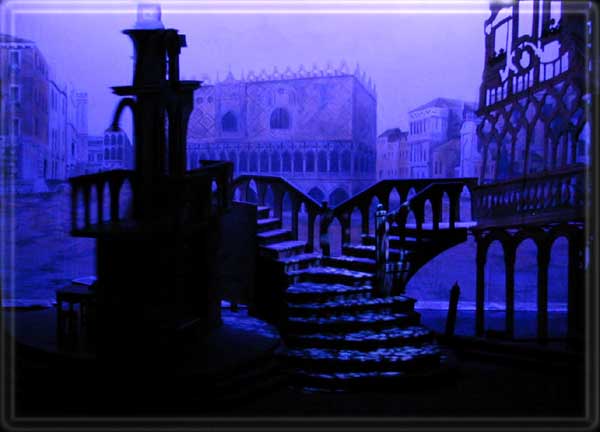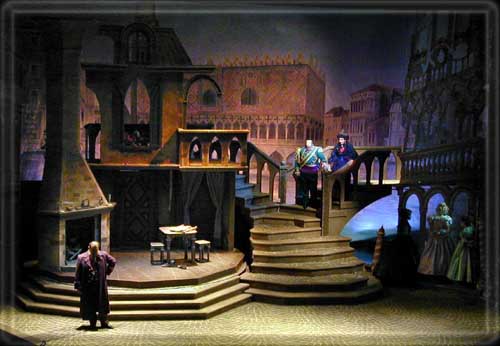|
|
A Tale of Cinderella
Rendering of the scenic design for production
of A Tale of Cinderella. The Design is by Richard Finkelstein. The original cast album is
available on Atlantic Records and the video is available on Warner Home Video. The
Video version has won awards at The Chicago International Film Festival and
Worldfest-Charleston, and was broadcast on many PBS stations, March, 1998. In May, 1998,
the musical title was a clue in The New York Times Crossword Puzzle (you know you've made
it when . . .). In the spring of 2001, an expanded edition of the musical toured
to major venues in New York State from Sheas' Theatre in Buffalo to The Danny
Kaye Playhouse in New York City. Depicted below are the design rendering
followed by three production photos.
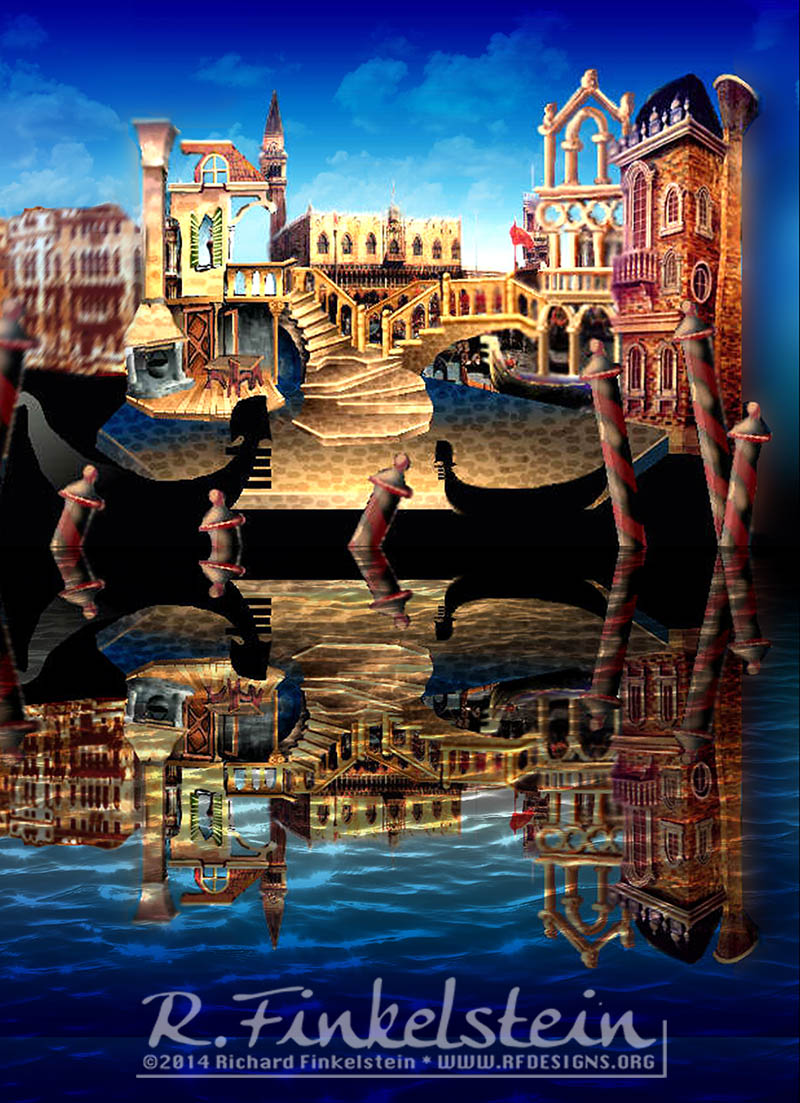
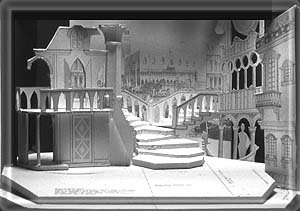 |
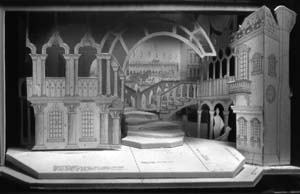 |
| White models |
|
Description of
the Settings:
The setting is a simple one, only made more
complex in scale and geometries. At the rear of the stage is a drop
depicting Venice, and specifically the Duke’s Palace. In it’s
latest incarnation, the drop was a dye-painted translucency
measuring 30'-0" in height by 90'-0" in width. Set against
this drop are a series of buildings forming the interesting
silhouettes of Venice. These structures include a domestic building,
down left, with a working 2nd story window. A series of
steps and bridges moves from up center, off up right and left. A
gondola moves in the canal under the up-left bridge, past a building
that resembles the lacy quality of a wedding cake.
Balancing the stage left buildings is the
home of Cinderella’s father. This is built on a turntable, so as
to serve for both exterior and interior scenes. The house is a two
story structure with the balcony connecting to the bridges of the
Venice set and with escape stairs at various rotational positions.
Cinderella’s kitchen within the interior
portion of the setting has a number of magical elements. The
fireplace is designed so that the fairy godmother can appear
magically (through the wonders of scrim and illusionary geometry)
from within the chimney, seemingly disjointed from her legs. The
glass slippers too appear from within the fire of the fireplace. At
another point of the action, the fairy godmother appears from within
the stone of the down left building.
In the original edition, these elements
formed the complete set, which also played on a raked stage. The
rake helped to make the transition between outside Cinderella’s
house and inside an easy one. Action could thus easily spill off the
house platform as more room was required. The rake also afforded a
logical way to provide for the canal in which the gondola ran on
tracks. The original design was also customized to exactly fill the
proscenium in the originating venue.
For the tour, the backdrop had been greatly
enlarged as had various other pieces. To allow for the widest
variety of proscenium widths, a multi-part Italianate portal was
designed and fabricated. Additional Venetian building elements were
provided to help extend the stage picture off right as well with the
larger venues.
The rake was eliminated in this edition and
replaced by a series of steps around the perimeter of the main
setting, and a ground-cloth was prepared with the fan-design
cobble-stone pattern.
This pattern of stones came from the second
of three editions of the design. Between the original edition, and
the touring edition, the set was re-designed for the Warner video
production. The coloration of the scenery was brought more within a
closer range while being boosted somewhat in chroma. Before this the
cobble-stones were in a linear pattern. For the video I opted to go
with the radial geometry so that shots from different angles would
better match. To allow for more room for choreography, the apron of
the stage was enlarged as was the kitchen area.
I was also engaged for the video, to design
some of the matte elements for post production and the resulting
combination rendering/matte-painting was adapted into the basis of
the rendering depicted in this portfolio.
In all versions, additional elements were
flown in for the ball and wedding scenes. These included a palace
drop made from layers of scrim-like materials and cut muslin to
allow for two story action within the columns arches and windows.
Performers were able to use the balcony of the house which was
directly behind the palace drop at these points. In the tour
edition, swags of flowers overhead completed the picture.
Conceptual Foundations:
It was really exciting to work so directly
with the playwright as well as the producer/director on this piece.
They really took a very fresh look at otherwise tired material,
ending up with something new, unique, and exciting. The romantic and
fantasy elements are still here, but in this version, a strong
foundation in dramaturgical reality is provided. Answered in this
version are the questions that dog other versions such as: If the
step mother is so bad, why did the father marry her? Or: Where did
Cinderella’s REAL mother go?
In this version the action was moved to
Venice for many many related reasons. First it helps greatly to
explain the situation. In this edition, the father is a merchant,
owning a fleet of ships. This takes him away from home frequently.
On one of these voyages, Cinderella’s mother passes away at home
while the father is gone. Later the scheme places the father away
from home allowing room for the evil deeds of the step mother.
Venice of course is also a center of glass arts, of course related
to the magic of the glass slipper. And...when we think of a ball,
the best of balls is to be found in the carnivals of Venice.
The element of water becomes important, not
only in representing Venice, but in the various references in this
script to cooking and the magic fluids of life (and food!). In each
of our editions the water motif has had greater expression, most
wonderfully within the translucent effects of the dye drop.
This edition of the production doubles the
romantic plots. While the traditional Cinderella/Prince romance is
maintained, an additional relationship is created between Cinderella’s
god-mother and a parallel god-father of the Prince. It is almost as
though there is a geometry of romance in this edition to parallel
the classical architectures of this magical city.
Fluid motion is important in this
production. The recording has almost double the number of song
titles as in most musical scores. The town square is always a flurry
of actions from the townspeople representing all classes and
cultures. I wanted to provided a scenic metaphor to match. In this
setting all the set changes flow without any stop in action. People
come and go in the gondola as the house rotates, or the palace flies
in. It is a particularly beautiful moment when all this happens
together with the music, lighting, and choreography.
Last, in this version, Cinderella and her
relationships have a much higher degree of relevant reality. This is
NOT a woman "waiting her prince to come". This Cinderella
is a woman of action and morals, who knows herself and what is
right. She is gritty and not afraid to be affirmative in her
actions. The is NOT a fairy tale figure in this edition.
Given this new and improved Cinderella
character, I opted to not move too much into the fairy-land motif
with the scenery. In this regard, moving instead into a more
operatic interpretation worked well. I took my images and forms from
paintings of Venice.
Comments From the Press:
Buffalo News, The. Kunz, Mary. 4/27/2001.
"'A Tale of Cinderella', a dreamy musical playing through Sunday at Shea's Performing Arts Center, is set in Venice. And a beautiful Venice it is! The sky is a deep twilight blue, the square ringed with lanterns. Footbridges cross a canal, and rooftops appear in the background."
Backstage. Stimac, Elias. 5/25/2001.
"The technical artists are all in prime form here as well with
Richard Finkelstein's versatile setting . . ."
Metroland. Hammann, Ralph. 12/27/1995.
"True, Richard Finkelstein's elegant medley of arches and soft walls isn't overproduced, as is the current fashion on Broadway. But I'll bet patrons would find its simplicity welcoming and exploring for two hours."
|
|


